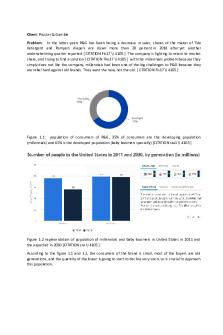Marketing Research - BUS2600, Professor Freeman Wu PDF

| Title | Marketing Research - BUS2600, Professor Freeman Wu |
|---|---|
| Author | Gracyn Smith |
| Course | Principles of Marketing |
| Institution | Vanderbilt University |
| Pages | 3 |
| File Size | 85.3 KB |
| File Type | |
| Total Downloads | 89 |
| Total Views | 128 |
Summary
BUS2600, Professor Freeman Wu...
Description
Why do companies need information about consumers (why is market research and information important)? How to segment/target How to focus advertising You learn from mistakes (Red Lobster, all-you-can-eat crab) Good marketing information enables marketers to… Gain competitive advantage Reduce financial and image risk (Red Lobster) Determine consumer attitudes Monitor the environment Gather competitive intelligence Coordinate strategy Measure performance Improve advertising credibility Gain management support for decisions Verify intuition Improve effectiveness Prepare SWOT Be prepared Maximize performance [understand consumer needs in order to create value for the customer] Need for information Managers need information about the environment (but there is so much information out there) Marketing research process 1. Define the problem and research objectives **most important step of the marketing research process What do we want to know? Ex. Coca Cola's big mistake In the 1980s, losing market share to Pepsi; did blind taste tests and determined that people liked Pepsi better; switched formula but flop; re-implemented original Coke thought they had a "taste problem" but maybe there was a deeper problem (need to reinvigorate the brand) Set research objectives Exploratory research Purpose: gain background info/better understanding of situation; define research problems; generate hypothesis Data: small samples; qualitative analysis (ex. interviews, focus groups, videos) Ex. Nissan Descriptive research Purpose: to describe characteristics of group; to estimate proportion of people who behave a certain way; to make specific predictions or generalizations about the target market Data: typically uses large samples; quantitative analysis/numbers (ex. customer satisfaction survey)
Causal research Purpose: to test cause and effect relationships (condition x causes outcome y) Tested through experiments (include independent and dependent variables) Goal: to determine how changes in x cause changes in y Must contain a control group (ex. people who are not hungry, a tip jar that has not been salted/already filled) 2. Develop the research plan and collect information Marketing research data includes primary and secondary data Primary data--new data collected specifically for the problem at hand Main types: observational research, focus groups, ethnographic research, data mining, survey research, experimental research, quasiexperiments (i.e. test market; Campbell soup) Observational research--involves gathering primary data by observing relevant people, actions, and situations (qualitative or quantitative) Ex. how long does it take people to choose laundry detergent (answer: 4 seconds, branding/images do not matter as much) Ex. P&G hair and body wash combo Ex. Kimberly-Clark easy-open aby wash (pump) Advantages: objective, accurate Disadvantages: cannot observe (underlying psychological variables, ex. motivation; you know the what but not the why), don't have access to past behaviors Focus groups--groups of respondents discuss a marketing problem by responding and reacting to each other Famous products that "failed" focus groups [**purpose of exploratory research (e.g. focus groups) is to clarify research problems and not to provide solutions; be careful not to make misleading generalizations using sample sizes too small to be representative of the wider population] Data mining Quantitative in nature Use of analytic technologies to quickly explore mountains of data to obtain useful info Ex. Facebook ads Survey research--most widely used method and is **best for descriptive research Flexible (i.e. by mail, online, in person) Fast and cost effective But people know that the are part of a study (may lie/give misleading answers; socially-desirable responding) Advantages: useful for measuring unobservable concepts (attitudes, knowledge, intentions, brand awareness, satisfaction, motivation, etc.)
Disadvantages: subject to socially-desirable responding, can measure correlation but not causation, question design can be poor (**important that questions are not leading, ambiguous, unanswerable, two questions in one, non-exhaustive, or have nonmutually exclusive answers) Secondary data--existing data not collected for the problem at hand, but for some other purpose; collected before or in place of primary data Sources of secondary data: internal and external (specifics on slides) Ex. Google Trends Advantages: cost, speed, could not get data otherwise Disadvantages: relevance, current, accuracy, impartial [**general rule of thumb: use secondary data first, then turn to primary data only if needed] 3. Implement the research plan--collecting and analyzing the data 4. Interpreting and reporting the findings...
Similar Free PDFs

Marketing Research
- 48 Pages

marketing research
- 3 Pages

Marketing research
- 2 Pages

Wawa Mintel Research Marketing
- 2 Pages

Marketing Research QUIZ 1
- 11 Pages

Chapter 10 Marketing Research
- 8 Pages

Resumen 10 - Marketing Research
- 7 Pages

Marketing Research Module-1
- 22 Pages

Marketing Research Proposal
- 17 Pages

Marketing research report conclusion
- 27 Pages

Marketing research report n2
- 3 Pages
Popular Institutions
- Tinajero National High School - Annex
- Politeknik Caltex Riau
- Yokohama City University
- SGT University
- University of Al-Qadisiyah
- Divine Word College of Vigan
- Techniek College Rotterdam
- Universidade de Santiago
- Universiti Teknologi MARA Cawangan Johor Kampus Pasir Gudang
- Poltekkes Kemenkes Yogyakarta
- Baguio City National High School
- Colegio san marcos
- preparatoria uno
- Centro de Bachillerato Tecnológico Industrial y de Servicios No. 107
- Dalian Maritime University
- Quang Trung Secondary School
- Colegio Tecnológico en Informática
- Corporación Regional de Educación Superior
- Grupo CEDVA
- Dar Al Uloom University
- Centro de Estudios Preuniversitarios de la Universidad Nacional de Ingeniería
- 上智大学
- Aakash International School, Nuna Majara
- San Felipe Neri Catholic School
- Kang Chiao International School - New Taipei City
- Misamis Occidental National High School
- Institución Educativa Escuela Normal Juan Ladrilleros
- Kolehiyo ng Pantukan
- Batanes State College
- Instituto Continental
- Sekolah Menengah Kejuruan Kesehatan Kaltara (Tarakan)
- Colegio de La Inmaculada Concepcion - Cebu




